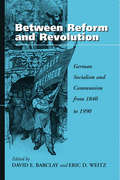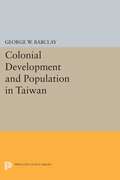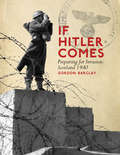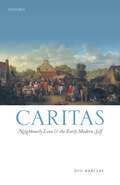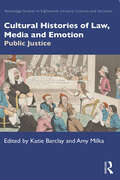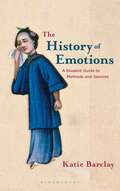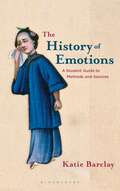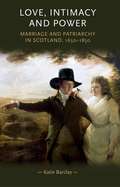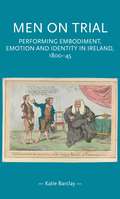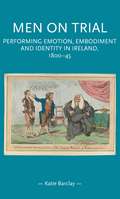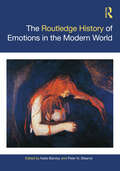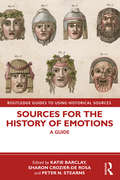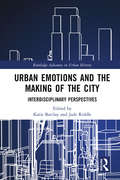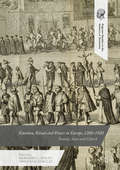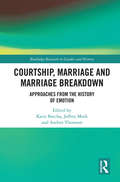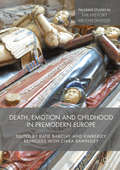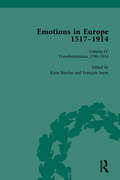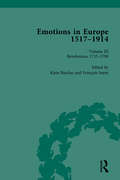- Table View
- List View
Between Reform and Revolution: German Socialism and Communism from 1840 to 1990
by David E. Barclay Eric D. WeitzThe powerful impact of Socialism and Communism on modern German history is the theme which is explored by the contributors to this volume. Whereas previous investigations have tended to focus on political, intellectual and biographical aspects, this book captures, for the first time, the methodological and thematic diversity and richness of current work on the history of the German working class and the political movements that emerged from it. Based on original contributions from U.S., British, and German scholars, this collection address a wide range of themes and problems.
Colonial Development and Population in Taiwan (PDF)
by George Watson BarclayAn unusual view of an agrarian region in the process of development by a colonial power. Taiwan (or Formosa), when it reverted to Chinese control in 1945, had been for fifty years the Japanese empire's most cherished foreign possession. Using the remarkable statistical data that the Japanese compiled to aid their administration—one of the most complete and creditable records for a population of this size that has ever been at the disposal of demographers—this book is able to present an authoritative picture of the social economic agricultural and demographic development of the island.Originally published in 1966.The Princeton Legacy Library uses the latest print-on-demand technology to again make available previously out-of-print books from the distinguished backlist of Princeton University Press. These editions preserve the original texts of these important books while presenting them in durable paperback and hardcover editions. The goal of the Princeton Legacy Library is to vastly increase access to the rich scholarly heritage found in the thousands of books published by Princeton University Press since its founding in 1905.
If Hitler Comes: Preparing for Invasion: Scotland 1940
by Gordon BarclayBetween May 1940 and the summer of 1941 the British people expected a German invasion that, had it succeeded, would have enslaved them into the Nazis' racist war. This period saw an unparalleled effort to prepare the defence of the UK against invasion. Scotland's nationally important heavy industries, vital Royal Navy bases, and one of the UK's key ports, were very vulnerable to the sort of airborne attack that had devastated the defences of Belgium. Everyone was certain that a Fifth Column of Nazi sympathisers and agents was working actively to spread rumours and despair, and to aid the invasion forces, and in reality the country was far from united. Although the 1939 - 45 War is the most written-about war in history there is no account of the heroic efforts made in those months to prepare Scotland for the inevitable invasion, and how the defences were intended to be used. This book tells that story, against the wider history of the period and its people, and describes what was built, and what now survives.
Caritas: Neighbourly Love and the Early Modern Self (Emotions in History)
by Katie BarclayCaritas, a form of grace that turned our love for our neighbour into a spiritual practice, was expected of all early modern Christians, and corresponded with a set of ethical rules for living that displayed one's love in the everyday. Caritas was not just a willingness to behave morally, to keep the peace, and to uphold social order however, but was expected to be felt as a strong passion, like that of a parent to a child. Caritas: Neighbourly Love and the Early Modern Self explores the importance of caritas to early modern communities, introducing the concept of the 'emotional ethic' to explain how neighbourly love become not only a code for moral living but a part of felt experience. As an emotional ethic, caritas was an embodied norm, where physical feeling and bodily practices guided right action, and was practiced in the choices and actions of everyday life. Using a case study of the Scottish lower orders, this book highlights how caritas shaped relationships between men and women, families, and the broader community. Focusing on marriage, childhood and youth, 'sinful sex', privacy and secrecy, and hospitality towards the itinerant poor, Caritas provides a rich analysis of the emotional lives of the poor and the embodied moral framework that guided their behaviour. Charting the period 1660 to 1830, it highlights how caritas evolved in response to the growing significance of romantic love, as well as new ideas of social relation between men, such as fraternity and benevolence.
Caritas: Neighbourly Love and the Early Modern Self (Emotions in History)
by Katie BarclayCaritas, a form of grace that turned our love for our neighbour into a spiritual practice, was expected of all early modern Christians, and corresponded with a set of ethical rules for living that displayed one's love in the everyday. Caritas was not just a willingness to behave morally, to keep the peace, and to uphold social order however, but was expected to be felt as a strong passion, like that of a parent to a child. Caritas: Neighbourly Love and the Early Modern Self explores the importance of caritas to early modern communities, introducing the concept of the 'emotional ethic' to explain how neighbourly love become not only a code for moral living but a part of felt experience. As an emotional ethic, caritas was an embodied norm, where physical feeling and bodily practices guided right action, and was practiced in the choices and actions of everyday life. Using a case study of the Scottish lower orders, this book highlights how caritas shaped relationships between men and women, families, and the broader community. Focusing on marriage, childhood and youth, 'sinful sex', privacy and secrecy, and hospitality towards the itinerant poor, Caritas provides a rich analysis of the emotional lives of the poor and the embodied moral framework that guided their behaviour. Charting the period 1660 to 1830, it highlights how caritas evolved in response to the growing significance of romantic love, as well as new ideas of social relation between men, such as fraternity and benevolence.
Cultural Histories of Law, Media and Emotion: Public Justice (Routledge Studies in Eighteenth-Century Cultures and Societies)
by Katie BarclayCultural Histories of Law, Media and Emotion: Public Justice explores how the legal history of long-eighteenth-century Britain has been transformed by the cultural turn, and especially the associated history of emotion.Seeking to reflect on the state of the field, 13 essays by leading and emerging scholars bring cutting-edge research to bear on the intersections between law, print culture and emotion in Britain across the eighteenth and nineteenth centuries. Divided into three sections, this collection explores the ‘public’ as a site of legal sensibility; it demonstrates how the rhetoric of emotion constructed the law in legal practice and in society and culture; and it highlights how approaches from cultural and emotions history have recentred the individual, the biography and the group to explain long-running legal-historical problems. Across this volume, authors evidence how engagements between cultural and legal history have revitalised our understanding of law’s role in eighteenth-century culture and society, not least deepening our understanding of justice as produced with and through the public.This volume is the ideal resource for upper-level undergraduates, postgraduates and scholars interested in the history of emotions as well as the legal history of Britain from the late seventeenth to the nineteenth century.
The History of Emotions: A Student Guide to Methods and Sources (Routledge Guides To Using Historical Sources Ser. #39)
by Katie BarclayThis student guide introduces the key concepts, theories and approaches to the history of emotions while teaching readers how to apply these ideas to historical source material. Covering the main emotions approaches and providing a range of global case studies and historical sources with which to apply learning, this textbook provides a ‘how to’ guide for those new to the field and for those learning how historians apply methods to source material. Written in clear and accessible language, each chapter is accompanied by further reading, while surveying many of the main areas of current research and providing ideas for personal research projects and further learning. This methodological guide is ideal for students taking modules on the History of Emotions, or for students on general Historical Skills modules.
The History of Emotions: A Student Guide to Methods and Sources (Routledge Guides To Using Historical Sources Ser.)
by Katie BarclayThis student guide introduces the key concepts, theories and approaches to the history of emotions while teaching readers how to apply these ideas to historical source material. Covering the main emotions approaches and providing a range of global case studies and historical sources with which to apply learning, this textbook provides a 'how to' guide for those new to the field and for those learning how historians apply methods to source material. Written in clear and accessible language, each chapter is accompanied by further reading, while surveying many of the main areas of current research and providing ideas for personal research projects and further learning. This methodological guide is ideal for students taking modules on the History of Emotions, or for students on general Historical Skills modules.
Love, Intimacy and Power: Marriage and patriarchy in Scotland, 1650–1850 (PDF) (Gender in History)
by Katie BarclayThrough an analysis of the correspondence of over one hundred couples from the Scottish elites across the seventeenth to nineteenth centuries, this book explores how ideas around the nature of emotional intimacy, love, and friendship within marriage adapted to a modernising economy and society. Patriarchy continued to be the central model for marriage across the period and as a result, women found spaces to hold power within the family, but could not translate it to power beyond the household. Comparing the Scottish experience to that across Europe and North America, Barclay shows that throughout the eighteenth-century, far from being a side-note in European history, Scottish ideas about gender and marriage became culturally dominant. This book will be vital to those studying and teaching Scottish social history, and those interested in the history of marriage and gender. It will also appeal to feminists interested in the history of patriarchy.
Love, Intimacy and Power: Marriage and patriarchy in Scotland, 1650–1850 (Gender in History)
by Katie BarclayWinner of the 2012 Senior Hume Brown Prize in Scottish History and the 2012 Women's History Network (UK) Book Prize Through an analysis of the correspondence of over one hundred couples from the Scottish elites across the seventeenth to nineteenth centuries, this book explores how ideas around the nature of emotional intimacy, love and friendship within marriage adapted to a modernising economy and society. Patriarchy continued to be the central model for marriage across the period and as a result, women found spaces to hold power within the family, but could not translate it to power beyond the household. Comparing the Scottish experience to that across Europe and North America, Barclay shows that throughout the eighteenth century, far from being a side-note in European history, Scottish ideas about gender and marriage became culturally dominant. Now available in paperback, this book will be vital to those studying and teaching Scottish social history, and those interested in the history of marriage and gender. It will also appeal to feminists interested in the history of patriarchy. 'An important and original study' WHN Book Prize 2012 Judges
Men on trial: Performing emotion, embodiment and identity in Ireland, 1800–45 (Gender in History)
by Katie BarclayMen on trial explores how the Irish perform ‘the self’ within the early nineteenth-century courtroom and its implications for law, society and nation. Drawing on new methodologies from the history of emotion, as well as theories of performativity and performative space, it emphasises that manliness was not simply a cultural ideal, but something practised, felt and embodied. Men on trial explores how gender could be a creative dynamic in productions of power. Targeted at scholars in Irish history, law and gender studies, this book argues that justice was not simply determined through weighing evidence, but through weighing men, their bodies, behaviours, and emotions. Moreover, in a context where the processes of justice were publicised in the press for the nation and the world, manliness and its role in the creation of justice became implicated in the making of national identity.
Men on trial: Performing emotion, embodiment and identity in Ireland, 1800–45 (Gender in History)
by Katie BarclayMen on trial explores how the Irish perform ‘the self’ within the early nineteenth-century courtroom and its implications for law, society and nation. Drawing on new methodologies from the history of emotion, as well as theories of performativity and performative space, it emphasises that manliness was not simply a cultural ideal, but something practised, felt and embodied. Men on trial explores how gender could be a creative dynamic in productions of power. Targeted at scholars in Irish history, law and gender studies, this book argues that justice was not simply determined through weighing evidence, but through weighing men, their bodies, behaviours, and emotions. Moreover, in a context where the processes of justice were publicised in the press for the nation and the world, manliness and its role in the creation of justice became implicated in the making of national identity.
The Routledge History of Emotions in the Modern World (Routledge Histories)
by Katie BarclayThe Routledge History of Emotions in the Modern World brings together a diverse array of scholars to offer an overview of the current and emerging scholarship of emotions in the modern world. Across thirty-six chapters, this work enters the field of emotion from a range of angles. Named emotions – love, anger, fear – highlight how particular categories have been deployed to make sense of feeling and their evolution over time. Geographical perspectives provide access to the historiographies of regions that are less well-covered by English-language sources, opening up global perspectives and new literatures. Key thematic sections are designed to intersect with critical historiographies, demonstrating the value of an emotions perspective to a range of areas. Topical sections direct attention to the role of emotions in relations of power, to intimate lives and histories of place, as products of exchanges across groups, and as deployed by new technologies and medias. The concepts of globalisation and modernity run through the volume, acting as foils for comparison and analytical tools. The Routledge History of Emotions in the Modern World is the perfect resource for all students and scholars interested in the history of emotions across the world from 1700.
Sources for the History of Emotions: A Guide (Routledge Guides to Using Historical Sources)
by Katie BarclayOffering insights on the wide range of sources that are available from across the globe and throughout history for the study of the history of emotions, this book provides students with a handbook for beginning their own research within the field. Divided into three parts, Sources for the History of Emotions begins by giving key starting points into the ethical, methodological and theoretical issues in the field. Part II shows how emotions historians have proved imaginative in their discovering and use of varied materials, considering such sources as rituals, relics and religious rhetoric, prescriptive literature, medicine, science and psychology, and fiction, while Part III offers introductions to some of the big or emerging topics in the field, including embodied emotions, comparative emotions, and intersectionality and emotion. Written by key scholars of emotions history, the book shows readers the ways in which different sources can be used to extract information about the history of emotions, highlighting the kind of data available and how it can be used in a field for which there is no convenient archive of sources. The focused discussion of sources offered in this book, which not only builds on existing research, but encourages further efforts, makes it ideal reading and a key resource for all students of emotions history.
Urban Emotions and the Making of the City: Interdisciplinary Perspectives (Routledge Advances in Urban History)
by Katie BarclayThis book brings together a vibrant interdisciplinary mix of scholars – from anthropology, architecture, art history, film studies, fine art, history, literature, linguistics and urban studies – to explore the role of emotions in the making and remaking of the city. By asking how urban boundaries are produced through and with emotion; how emotional communities form and define themselves through urban space; and how the emotional imaginings of urban spaces impact on histories, identities and communities, the volume advances our understanding of 'urban emotions' into discussions of materiality, power and embodiment across time and space.
Emotion, Ritual and Power in Europe, 1200-1920: Family, State and Church (Palgrave Studies in the History of Emotions)
by Katie Barclay Merridee L. BaileyThis volume spans the fourteenth to nineteenth centuries, across Europe and its empires, and brings together historians, art historians, literary scholars and anthropologists to rethink medieval and early modern ritual. The study of rituals, when it is alert to the emotions which are woven into and through ritual activities, presents an opportunity to explore profoundly important questions about people’s relationships with others, their relationships with the divine, with power dynamics and importantly, with their concept of their own identity. Each chapter in this volume showcases the different approaches, theories and methodologies that can be used to explore emotions in historical rituals, but they all share the goal of answering the question of how emotions act within ritual to inform balances of power in its many and varied forms. Chapter 5 of this book is available open access under a CC BY 4.0 license.
Courtship, Marriage and Marriage Breakdown: Approaches from the History of Emotion (Routledge Research in Gender and History #39)
by Katie Barclay Jeffrey Meek Andrea ThomsonThis book explores the history of marriage and marriage-like relationships across five continents from the seventeenth century to the present day. Across fourteen chapters, leading marriage scholars examine how the methodologies from the new history of emotions contribute to our understanding of marriage, seeking to uncover not only personal feeling but also the political and social implications of emotion. They highlight how marriage as an institution has been shaped not just by law and society but also by individual and community choices, desires and emotional values. Importantly, they also emphasize how the history of non-traditional and same-sex relationships and their emotions have long played an important role in determining the nature of marriage as an institution and emotional union. In doing so, this collection allows us to rethink both the past and present of marriage, destabilizing a story of a stable institution and opening it up as a site of contest, debate and feeling.
Courtship, Marriage and Marriage Breakdown: Approaches from the History of Emotion (Routledge Research in Gender and History #39)
by Katie Barclay Jeffrey Meek Andrea ThomsonThis book explores the history of marriage and marriage-like relationships across five continents from the seventeenth century to the present day. Across fourteen chapters, leading marriage scholars examine how the methodologies from the new history of emotions contribute to our understanding of marriage, seeking to uncover not only personal feeling but also the political and social implications of emotion. They highlight how marriage as an institution has been shaped not just by law and society but also by individual and community choices, desires and emotional values. Importantly, they also emphasize how the history of non-traditional and same-sex relationships and their emotions have long played an important role in determining the nature of marriage as an institution and emotional union. In doing so, this collection allows us to rethink both the past and present of marriage, destabilizing a story of a stable institution and opening it up as a site of contest, debate and feeling.
Cultural Histories of Law, Media and Emotion: Public Justice (Routledge Studies in Eighteenth-Century Cultures and Societies)
by Katie Barclay Amy MilkaCultural Histories of Law, Media and Emotion: Public Justice explores how the legal history of long-eighteenth-century Britain has been transformed by the cultural turn, and especially the associated history of emotion.Seeking to reflect on the state of the field, 13 essays by leading and emerging scholars bring cutting-edge research to bear on the intersections between law, print culture and emotion in Britain across the eighteenth and nineteenth centuries. Divided into three sections, this collection explores the ‘public’ as a site of legal sensibility; it demonstrates how the rhetoric of emotion constructed the law in legal practice and in society and culture; and it highlights how approaches from cultural and emotions history have recentred the individual, the biography and the group to explain long-running legal-historical problems. Across this volume, authors evidence how engagements between cultural and legal history have revitalised our understanding of law’s role in eighteenth-century culture and society, not least deepening our understanding of justice as produced with and through the public.This volume is the ideal resource for upper-level undergraduates, postgraduates and scholars interested in the history of emotions as well as the legal history of Britain from the late seventeenth to the nineteenth century.
Death, Emotion and Childhood in Premodern Europe (Palgrave Studies in the History of Childhood)
by Katie Barclay Kimberley Reynolds Ciara RawnsleyThis book draws on original material and approaches from the developing fields of the history of emotions and childhood studies and brings together scholars from history, literature and cultural studies, to reappraise how the early modern world reacted to the deaths of children. Child death was the great equaliser of the early modern period, affecting people of all ages and conditions. It is well recognised that the deaths of children struck at the heart of early modern families, yet less known is the variety of ways that not only parents, but siblings, communities and even nations, responded to childhood death. The contributors to this volume ask what emotional responses to child death tell us about childhood and the place of children in society. Placing children and their voices at the heart of this investigation, they track how emotional norms, values, and practices shifted across the fifteenth to nineteenth centuries through different religious, legal and national traditions. This collection demonstrates that child death was not just a family matter, but integral to how communities and societies defined themselves. Chapter 5 of this book is available open access under a CC BY 4.0 license at link.springer.com.
Urban Emotions and the Making of the City: Interdisciplinary Perspectives (Routledge Advances in Urban History)
by Katie Barclay Jade RiddleThis book brings together a vibrant interdisciplinary mix of scholars – from anthropology, architecture, art history, film studies, fine art, history, literature, linguistics and urban studies – to explore the role of emotions in the making and remaking of the city. By asking how urban boundaries are produced through and with emotion; how emotional communities form and define themselves through urban space; and how the emotional imaginings of urban spaces impact on histories, identities and communities, the volume advances our understanding of 'urban emotions' into discussions of materiality, power and embodiment across time and space.
Sources for the History of Emotions: A Guide (Routledge Guides to Using Historical Sources)
by Katie Barclay Sharon Crozier-De Rosa Peter N. StearnsOffering insights on the wide range of sources that are available from across the globe and throughout history for the study of the history of emotions, this book provides students with a handbook for beginning their own research within the field. Divided into three parts, Sources for the History of Emotions begins by giving key starting points into the ethical, methodological and theoretical issues in the field. Part II shows how emotions historians have proved imaginative in their discovering and use of varied materials, considering such sources as rituals, relics and religious rhetoric, prescriptive literature, medicine, science and psychology, and fiction, while Part III offers introductions to some of the big or emerging topics in the field, including embodied emotions, comparative emotions, and intersectionality and emotion. Written by key scholars of emotions history, the book shows readers the ways in which different sources can be used to extract information about the history of emotions, highlighting the kind of data available and how it can be used in a field for which there is no convenient archive of sources. The focused discussion of sources offered in this book, which not only builds on existing research, but encourages further efforts, makes it ideal reading and a key resource for all students of emotions history.
Emotions in Europe, 1517-1914: Volume IV: Transformations, 1789-1914
by Katie Barclay François SoyerThis volume of primary sources focuses on the history of emotions in Europe and its empires between 1789 and 1914. The study ends with WW1, by which point psychology and modern frameworks for the self had become standard knowledge. The study examines the subjects of the self, family and community, religion, politics and law, science and philosophy, and art and culture. Sources include letters, diaries, legal papers, institutional records, newspapers, science and philosophical writings, literature and art from a diversity of voices and perspectives. Accompanied by extensive editorial commentary, this collection will be of great interest to students of history and literature.
Emotions in Europe, 1517-1914: Volume I: Reformations,1517-1602
by Katie Barclay François SoyerThis volume of primary sources focuses on the history of emotions in Europe and its empires between 1517 and 1602. The Reformation in 1517 was a key transformative moment in European history that required people to rethink the self, belief, and scientific knowledges – all of which shaped and were shaped by emotion. The study examines the subjects of the self, family and community, religion, politics and law, science and philosophy, and art and culture. Sources include letters, diaries, legal papers, institutional records, newspapers, science and philosophical writings, literature and art from a diversity of voices and perspectives. Accompanied by extensive editorial commentary, this collection will be of great interest to students of history and literature.
Emotions in Europe, 1517-1914: Volume III: Revolutions, 1714-1789
by Katie Barclay François SoyerThis volume of primary sources focuses on the history of emotions in Europe and its empires between 1714 and 1789. The study examines the subjects of the self, family and community, religion, politics and law, science and philosophy, and art and culture. Sources include letters, diaries, legal papers, institutional records, newspapers, science and philosophical writings, literature and art from a diversity of voices and perspectives. Accompanied by extensive editorial commentary, this collection will be of great interest to students of history and literature.
